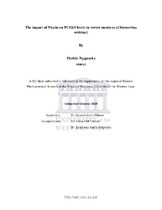| dc.contributor.advisor | Obikeze, Kenechukwu | |
| dc.contributor.advisor | Chauke, Chesa Gift | |
| dc.contributor.author | Ngqaneka, Thobile | |
| dc.date.accessioned | 2021-03-23T09:49:54Z | |
| dc.date.available | 2021-03-23T09:49:54Z | |
| dc.date.issued | 2020 | |
| dc.identifier.uri | http://hdl.handle.net/11394/8016 | |
| dc.description | Magister Pharmaceuticae - MPharm | en_US |
| dc.description.abstract | Cardiovascular diseases (CVDs) such as ischaemic heart diseases, heart failure and stroke
remain a major cause of death globally. Various deep-rooted factors influence CVD
development; these include but are not limited to elevated blood lipids, high blood pressure,
obesity and diabetes. A considerable number of proteins are involved directly and indirectly in
the transport, maintenance and elimination of plasma lipids, including high and low-density
lipoprotein cholesterol (HDL-C and LDL-C). There are several mechanisms involved in the
removal of LDL particles from systemic circulation. One such mechanism is associated with
the gene that encodes proprotein convertase subtilisin/kexin type 9 (PCSK9), which has
become an exciting therapeutic target for the reduction of residual risk of CVDs. Currently,
statins are the mainstay treatment to reduce LDL-C, and a need exists to further develop more
effective LDL-C-lowering drugs that might supplement statins. | en_US |
| dc.language.iso | en | en_US |
| dc.publisher | University of the Western Cape | en_US |
| dc.subject | Atherosclerosis | en_US |
| dc.subject | Cardiovascular disease (CVD) | en_US |
| dc.subject | High-density lipoprotein (HDL) | en_US |
| dc.subject | Lipids | en_US |
| dc.subject | Low-density lipoprotein (LDL) | en_US |
| dc.title | The impact of Niacin on PCSK9 levels in vervet monkeys (Chlorocebus aethiops) | en_US |
| dc.rights.holder | University of the Western Cape | en_US |

